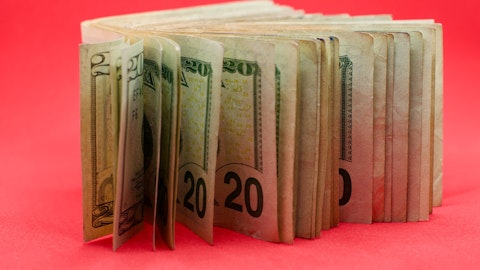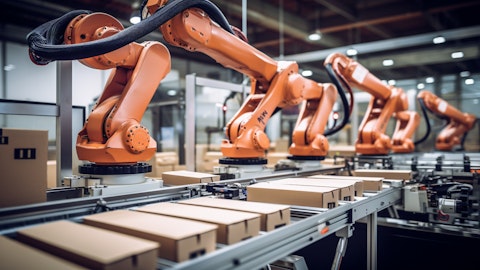Jakob Cakarnis: Just one more for Michael, if I can. Just on the net interest guidance, obviously, a little bit lower than where you were guiding to initially, how much of that’s the movements in forward curves and expectations for rate or interest rate declines or cash rate declines in the US through the balance of the year, please?
Michael Casamento: Yes, sure. So, we — you saw that we brought our guidance just slightly down from kind of a range of $320 million to $340 million down to kind of $315 million to $330 million. That’s really all on the back of the forward curves and the interest rate hike would appear been reached its peak now, and potentially, you might see one rate reduction late in our fiscal year. But really, that’s the slight improvement is really on the back of that forward curve. And after tax, it’s a pretty minimal impact on the full year guidance.
Operator: Your next question comes from the line of Cameron McDonald from E&P. Please go ahead.
Cameron McDonald: Hey good morning guys. Question for Mike, just in terms of — well, the tax rate and then the capital structure. So, the tax rate sitting sort of around sort of under 19%. And where — what jurisdictions are you getting a tax benefit from given the corporate tax rate in most of your jurisdictions is in excess of certainly of that number, but in excess of sort of $20 million?
Michael Casamento: Yes. Look, I think we operate across a broad range of countries globally. And in addition to that, the mix of earnings can be different in every geography and location. And then the overall underlying performance of the business can change. So, when you wrap that all up for our business, we’re guiding to 18% to 20% tax rate. We’ve typically been around that 20% range for a long period of time. So, it’s really just the combination of the earnings, the country mix and the underlying performance of the business.
Ron Delia: And the differences in deductibility of different expenses by jurisdiction, right, which then, obviously, you have to factor in, in addition to the headline tax rates in those jurisdictions.
Cameron McDonald: Okay. Thank you. And then just in terms of the capital structure, comments earlier about the balance sheet and the leverage. Part of the investment thesis has been EPS growth, a big chunk of that has been undertaken through share buybacks. What — how — what’s the sort of leverage ratio that we should be expecting before we would start to see a discussion around the buyback being reimplemented? Is it — do we have to get back down to sort of the mid-2s? I think the last time you had a buyback active was sort of 2.7 times leverage?
Ron Delia: Well, listen, we’ve bought back — remember, it’s buybacks and MA is the way we think about the discretionary cash flow for the business. And we bought back over the last. We will have bought back over three fiscal years and acquired to the tune of about $1.2 billion. So, we will have done over $1 billion in buybacks, and we will have invested somewhere close to $200 million in investments and acquisitions. So, that’s essentially three years of discretionary cash that’s been invested in the business. It’s a little bit lumpy. It’s not exactly even over the three-year period, but that’s been what we’ve done. I think from a leverage range perspective, more often than not, we’re going to be between 2.5 and 3 times. Obviously, we’re comfortable being above that, particularly when there’s good reasons for it as there is at the moment.
And we’ll be continuing to evaluate capital management or buyback opportunities in conjunction with M&A opportunities on a go-forward basis, and that includes now.
Operator: Your next question comes from the line of Mike Roxland from Truist Securities. Please go ahead.
Michael Roxland: Thank you, Ron, Michael, Tracy for taking my questions. Actually, just one question because a lot of material already was covered here. Quickly on just protein packaging, Ron. I know it was discussed earlier in response to a question, I think you discussed it, I think, last quarter. Can you just describe whether there are any nuances in your business, maybe around equipment, for instance, that would make you unable to compete with some of it with a large player in the industry or some of the — some of your larger peers? I know are you intentionally participating in different parts of the market to avoid going head on with some of the larger players. And just lastly, where do you think this — where would you like this business to be on a revenue basis, let’s say, in five years or 10 years?
Ron Delia: Yes. Look, it’s a great question. The biggest challenge we have at the moment is the lack of installed base. So, there’s a massive installed base that got a lot of legacy behind it. in the industry as — given the way the industry has evolved over several decades. And from an equipment perspective, we’re — well, firstly, I would say we’re more open source — we bought Moda, obviously. So, we’ve — we’re prioritizing Moda equipment, but we’re more agnostic to the actual equipment installation. And we think we’ve got great — and the primary basis of competition here, we think, ultimately, will be on the film. And that’s what we’re aspiring to do is to grow the film business, enabled and facilitated with a full-service offering, which includes not only the machinery but the technical service that is so important in this industry to the customers to help them optimize their operations.
So, it’s really a total system solution that we’re going to go to market with now and we’re starting to go to market with really for the first time. And as far as how big can the business get and what are our aspirations for it? I mean, look, I’m not going to dimension it here, it’s a big, important business for us already. It’s a tough time to be asking for a lot out of the business as it weathers some of the destocking and some of the softness in the general beef cycle, in particular or meat cycle, I should say. But it’s a that we have aspirations to grow at sort of mid- to high single-digits and good margins for the foreseeable future.
Operator: Your next question comes from the line of John Purtell from Macquarie. Please go ahead.
John Purtell: Good day Ron and Michael, I hope you will. Just a couple of questions, please. In terms of your second half EPS guide, previously, it was up for the second half, up mid-single-digit in constant currency, think you mentioned Q3 EPS down mid-single-digit, were your expectation in Q4 up in single-digits. So, it looks like the Q3 guide is weaker. Is that reflecting a lower volume starting point?
Michael Casamento: Look, overall, John, I guess we actually held our guidance. So, — and you’re right, we’ve guided to volumes mid-single-digit down in Q3 and EPS down mid-single-digit. And in Q4, we’re expecting trajectory to improve through the half on the volumes, volumes down low single-digit. And just on the back of some of the things that Ron touched on earlier and also the earnings trajectory of our business Q4 is our biggest quarter, that’s why we’re expecting mid-single-digit EPS growth in Q4. So, really not a lot of change. I guess what we have seen is that the volume trajectory is perhaps a little softer than we previously anticipated. And that was really on the back of that destocking, particularly in healthcare and North America beverage, where we’re expecting that to continue through Q3 and perhaps into Q4.
We are offsetting that with continued cost out and we have confidence in the underlying performance of the business with the structural initiatives that we’ve put in place and touch on already getting $35 million in the second half, the ongoing cost agenda and discretionary spend management. So, not a lot of change really to our guidance overall. I think we — perhaps we did a little better in H1. But generally speaking we’re holding the range and we feel pretty good about the drivers behind the $0.67 to $0.71 range.
John Purtell: And just the second one, just to be interested in what you’re seeing from the consumer. Obviously, elasticity of demand has been an ongoing factor, and it looks like the FMCG companies are still pushing price.
Ron Delia: Yes. Look, I mean, the best proxy is probably the scanner data that we look at, and I’m sure you look at it as well. I mean, we still see a generally consumer environment. And — that’s true across the staples that we’re supplying packaging for. You still see in the US general scan data, which, obviously, there’s a lot of nuance that you need to unpack. But generally speaking, kind of low single-digit declines in the calendar fourth quarter that’s just passed, Europe may be modestly better overall, but at a sub level, you still see lots of softness and lots of modest declines. You see some evidence of down-trading in some parts of the business. You see on the margin, maybe some modest shift, and I wouldn’t make too much into this, but you see some modest shifts in some categories like pet food and maybe even in coffee where you might see different formats doing better.
We certainly see it — we believe we see it in the beverage business. In the case of carbonated soft drinks, where we know that the value pack has historically been the can, if you’re going to buy 12 or 24 cans or units of a soft drink, you’re likely to buy it in a can and that has continued. So, I think generally, John, the consumer environment is pretty soft. There are some reasons for potential optimism if the brand owners toggle the dial a little bit between price recovery and maximizing volume, but we are absolutely not baking that into our assumptions on volumes going forward. But that will take as nice to have if it happens.




